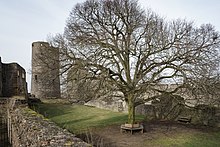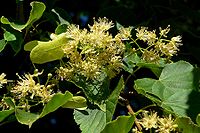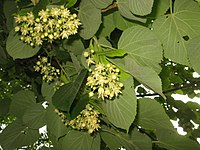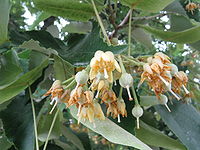Tilia
| Tilia Temporal range:
| |
|---|---|

| |
| Tilia tomentosa, cultivated at the Morton Arboretum near Chicago | |
| Scientific classification | |
| Kingdom: | Plantae |
| Clade: | Tracheophytes |
| Clade: | Angiosperms |
| Clade: | Eudicots |
| Clade: | Rosids |
| Order: | Malvales |
| Family: | Malvaceae |
| Subfamily: | Tilioideae |
| Genus: | Tilia L. |
| Species | |
|
About 30 | |
Tilia is a genus of about 30 species of trees or bushes, native throughout most of the temperate Northern Hemisphere. The tree is known as linden for the European species, and basswood for North American species.[1][2] In Britain and Ireland they are commonly called lime trees, although they are not related to the citrus lime. The genus occurs in Europe and eastern North America, but the greatest species diversity is found in Asia. Under the Cronquist classification system, this genus was placed in the family Tiliaceae, but genetic research summarised by the Angiosperm Phylogeny Group has resulted in the incorporation of this genus, and of most of the previous family, into the Malvaceae.
Tilia species are mostly large, deciduous trees, reaching typically 20 to 40 m (65 to 130 ft) tall, with oblique-cordate (heart-shaped) leaves 6 to 20 cm (2+1⁄4 to 7+3⁄4 in) across. As with elms, the exact number of species is uncertain, as many of the species can hybridise readily, both in the wild and in cultivation. They are hermaphroditic, having perfect flowers with both male and female parts, pollinated by insects.
Tilia is the only known ectomycorrhizal genus in the family Malvaceae. Studies of ectomycorrhizal relations of Tilia species indicate a wide range of fungal symbionts and a preference toward Ascomycota fungal partners.[3][4][5]
Name
The genus is generally called "lime" or "linden" in Britain[6] and "linden", "lime", or "basswood" in North America.[2]
"Lime" is an altered form of Middle English lind, in the 16th century also line, from Old English feminine lind or linde, Proto-Germanic *lindō, cognate to Latin lentus "flexible" and Sanskrit latā "liana". Within Germanic languages, English "lithe", German lind "lenient, yielding" are from the same root.
"Linden" was originally the adjective, "made from linwood or lime-wood" (equivalent to "wooden" or "oaken"); from the late 16th century, "linden" was also used as a noun, probably influenced by translations of German romance, as an adoption of Linden, the plural of German Linde.[citation needed] Neither the name nor the tree is related to the citrus fruit called "lime" (Citrus aurantifolia, family Rutaceae). Another common name used in North America is basswood, derived from bast, the name for the inner bark (see Uses, below). Teil is an old name for the lime tree.
Latin tilia is cognate to Greek πτελέᾱ, ptelea, "elm tree", τιλίαι, tiliai, "black poplar" (Hes.), ultimately from a Proto-Indo-European word *ptel-ei̯ā with a meaning of "broad" (feminine); perhaps "broad-leaved" or similar.[citation needed]
Description


The Tilia's sturdy trunk stands like a pillar and the branches divide and subdivide into numerous ramifications on which the twigs are fine and thick. In summer, these are profusely clothed with large leaves and the result is a dense head of abundant foliage.[7]
The leaves of all the Tilia species are heart-shaped, and most are asymmetrical. The tiny, pea-like fruit hangs attached to a ribbon-like, greenish-yellow bract whose apparent purpose is to launch the ripened seed clusters just a little beyond the parent tree. The flowers of the European and American Tilia species are similar, except the American ones bear a petal-like scale among their stamens and the European varieties are devoid of these appendages. All of the Tilia species may be propagated by cuttings and grafting, as well as by seed. They grow rapidly in rich soil, but are subject to the attack of many insects. Tilia is notoriously difficult to propagate from seed unless collected fresh in fall. If allowed to dry, the seeds go into a deep dormancy and take 18 months to germinate.[7]
In particular, aphids are attracted by the rich supply of sap, and are in turn often "farmed" by ants for the production of the sap, which the ants collect for their own use, and the result can often be a dripping of excess sap onto the lower branches and leaves, and anything else below. Cars left under the trees can quickly become coated with a film of the syrup ("honeydew") thus dropped from higher up. The ant/aphid "farming" process does not appear to cause any serious damage to the trees.
-
Leaf of common lime (Tilia × europaea) showing venation
-
Tilia flowers
-
Tilia fruit
-
The venation within a Tilia bract
History

In Europe, some linden trees reached considerable ages. A coppice of T. cordata in Westonbirt Arboretum in Gloucestershire is estimated to be 2,000 years old.[8] In the courtyard of the Imperial Castle at Nuremberg is a Tilia, which by tradition recounted in 1900, was planted by the Empress Cunigunde, the wife of Henry II of Germany circa 1000. The Tilia of Neuenstadt am Kocher in Baden-Württemberg, Germany, was estimated at 1000 years old when it fell.[7] The Alte Linde tree of Naters, Switzerland, is mentioned in a document in 1357 and described by the writer at that time as already magnam (large). A plaque at its foot mentions that in 1155, a linden tree was already on this spot. The Najevnik linden tree (Slovene: Najevska lipa), a 700-year-old T. cordata, is the thickest tree in Slovenia.[9]
- The excellence of the honey of the far-famed Hyblaean Mountains[10] was due to the linden trees that covered its sides and crowned its summit.
- Lime fossils have been found in the Tertiary formations of Grinnell Land, Canada, at 82°N latitude, and in Svalbard, Norway. Sapporta believed he had found there the common ancestor of the Tilia species of Europe and America.[7]
Uses

The linden is recommended as an ornamental tree when a mass of foliage or a deep shade is desired.[7] It produces fragrant and nectar-producing flowers and is an important honey plant for beekeepers, giving rise to a pale but richly flavoured monofloral honey. In European and North American herbal medicine, the flowers are also used for herbal teas and tinctures. The flowers are used for herbal tea in the winter in Greece and Turkey.
In English landscape gardens, avenues of linden trees were fashionable, especially during the late 17th and early 18th centuries. Many country houses have a surviving "lime avenue" or "lime walk", the example at Hatfield House was planted between 1700 and 1730.[11] The fashion was derived from the earlier practice of planting lindens in lines as shade trees in Germany, the Netherlands, Belgium and northern France. Most of the trees used in British gardens were cultivars propagated by layering in the Netherlands.[12]
Wood

Linden trees produce soft and easily worked timber, which has very little grain and a density of 560 kg/m3.[13] It was often used by Germanic tribes for constructing shields. It is a popular wood for model building and for intricate carving. Especially in Germany, it was the classic wood for sculpture from the Middle Ages onwards and is the material for the elaborate altarpieces of Veit Stoss, Tilman Riemenschneider, and many others. In England, it was the favoured medium of the sculptor Grinling Gibbons[14] (1648–1721). The wood is used in marionette- and puppet-making and -carving. Having a fine, light grain and being comparatively light in weight, it has been used for centuries for this purpose; despite the availability of modern alternatives, it remains one of the main materials used as of 2015[update].
Ease of working and good acoustic properties also make limewood popular for electric and bass guitar bodies and for wind instruments such as recorders. Percussion manufacturers sometimes use Tilia as a material for drum shells, both to enhance their sound and for their aesthetics.[citation needed]
Linden wood is also the material of choice for window blinds and shutters. Real-wood blinds are often made from this lightweight but strong and stable wood, which is well suited to natural and stained finishes.[citation needed]
Bark
Known in the trade as basswood, particularly in North America, its name originates from the inner fibrous bark of the tree, known as bast. A strong[15] fibre is obtained from the tree by peeling off the bark and soaking it in water for a month, after which the inner fibres can be easily separated. Bast obtained from the inside of the bark of the Tilia japonica tree has been used by the Ainu people of Japan to weave their traditional clothing, the attus. Excavations in Britain have shown that lime tree fibre was preferred for clothing there during the Bronze Age.[16] Similar fibres obtained from other plants are also called bast: see Bast fibre.
Phytochemicals and folk medicine
The dried flowers are mildly sweet and sticky, and the fruit is somewhat sweet and mucilaginous. Linden flower tea has a pleasing taste, due to the aromatic volatile oil found in the flowers. Phytochemicals in the Tilia flowers include flavonoids and tannins with astringent properties.[17] In traditional medicine, Tilia flowers have been used as tea for treatment of respiratory diseases.[17][medical citation needed]
In his compendium Food for Free, Richard Mabey includes a recipe for tilleul tea, popular in France, made with the flowers of the Lime tree, described as "one of the very best teas of all wild flowers" and notes that the tree's leaves can be eaten in salad or as a sandwich filling.[18]
The nectar contains a major secondary metabolite with the trivial name tiliaside (1-[4-(1-hydroxy-1-methylethyl)-1,3-cyclohexadiene-1-carboxylate]-6-O-β-D-glucopyranosyl-β-D-glucopyranose) which is transformed in the gut of bumble bees to the aglycone (i.e., the gentiobiose group is cleaved) which is bioactive against a common and debilitating gut parasite of bumble bees, Crithidia bombi. This naturally occurring compound may support bees to manage the burden of disease - one of the major contributors to pollinator decline.[19]
Other uses
Usually, the double-flowered species are used to make perfumes.[citation needed] The leaf buds and young leaves are also edible raw.[20][21]
Tilia species are used as food plants by the larvae of some Lepidoptera; see List of Lepidoptera that feed on Tilia.
Classification
This list comprises the most widely accepted species, hybrids, and cultivars".






Species
- Tilia americana L. – American basswood, American linden
- Tilia amurensis – Amur lime, Amur linden
- Tilia caroliniana – Carolina basswood
- Tilia chinensis – Chinese linden
- Tilia chingiana Hu & W.C.Cheng
- Tilia cordata Mill. – Small-leaved lime, little-leaf linden or greenspire linden
- Tilia dasystyla Steven
- Tilia henryana Szyszyl. – Henry's lime, Henry's linden
- Tilia hupehensis – Hubei lime
- Tilia insularis
- Tilia intonsa
- Tilia japonica – Japanese lime, shina (when used as a laminate)
- †Tilia johnsoni Wolfe & Wehr Eocene; Washington and British Columbia
- Tilia kiusiana
- Tilia mandshurica – Manchurian lime
- Tilia maximowicziana
- Tilia miqueliana
- Tilia mongolica Maxim. – Mongolian lime, Mongolian linden
- Tilia nasczokinii – Nasczokin's lime, Nasczokin's linden
- Tilia nobilis
- Tilia officinarum
- Tilia oliveri – Oliver's lime
- Tilia paucicostata
- Tilia platyphyllos Scop. – large-leaved lime
- Tilia rubra – Red stem lime (syn. T. platyphyllos var. rubra)
- Tilia tomentosa Moench – silver lime, silver linden
- Tilia tuan Szyszyl.
Hybrids and cultivars
- Tilia × euchlora (T. dasystyla × T. cordata)
- Tilia × europaea – Common lime (T. cordata × T. platyphyllos; syn. T. × vulgaris)
- Tilia × petiolaris (T. tomentosa × T. ?)
- Tilia 'Flavescens' – Glenleven linden (T. americana × T. cordata)
- Tilia 'Moltkei' (T. americana × T. petiolaris)
- Tilia 'Orbicularis' (hybrid, unknown origin)
- Tilia 'Spectabilis' (hybrid, unknown origin)
Gallery
-
Tilia heterophylla (syn. T. monticola)
See also
- International World War Peace Tree, a Tilia tree that stands as a sign of Germany's armistice with the United States
- Lime tree in culture
- Matryoshka doll, made from linden trees
- St Lawrence Lime, a former lime tree in Canterbury, England
References
- ^ USDA, NRCS (n.d.). "Tilia". The PLANTS Database (plants.usda.gov). Greensboro, North Carolina: National Plant Data Team. Retrieved 10 December 2015.
- ^ a b "Linden, definition". Merriam Webster dictionary. Retrieved May 25, 2020.
- ^ Timonen, Sari; Kauppinen, Pauliina (January 2008). "Mycorrhizal colonisation patterns of Tilia trees in street, nursery and forest habitats in southern Finland". Urban Forestry & Urban Greening. 7 (4): 265–276. doi:10.1016/j.ufug.2008.08.001.
- ^ Rudawska, Maria; Kujawska, Marta; Leski, Tomasz; Janowski, Daniel; Karliński, Leszek; Wilgan, Robin (April 2019). "Ectomycorrhizal community structure of the admixture tree species Betula pendula, Carpinus betulus, and Tilia cordata grown in bare-root forest nurseries". Forest Ecology and Management. 437: 113–125. doi:10.1016/j.foreco.2019.01.009. S2CID 91789869.
- ^ Janowski, Daniel; Nara, Kazuhide (November 2021). "Unique host effect of Tilia japonica on ectomycorrhizal fungal communities independent of the tree's dominance: A rare example of a generalist host?". Global Ecology and Conservation. 31: e01863. doi:10.1016/j.gecco.2021.e01863. S2CID 244182315.
- ^ Brown, Lesley (ed.). 2002. Shorter Oxford English Dictionary, vol. 1, A–M. 5th ed. Oxford: Oxford University Press, p. 1600.
- ^ a b c d e Keeler, Harriet L. (1900). Our Native Trees and How to Identify Them. New York: Charles Scribner's Sons. pp. 24–31.
- ^ Podlewska, Katrina (March 4, 2013). "Celebrating Westonbirt's 2000 Year Old Lime". Friends of Westonbirt Arboretum. Retrieved May 25, 2020.
- ^ Šmid Hribar, Mateja. "Najevska lipa" [Najevnik Linden Tree]. In Šmid Hribar, Mateja; Golež, Gregor; Podjed, Dan; Kladnik, Drago; Erhartič, Bojan; Pavlin, Primož; Ines, Jerele (eds.). Enciklopedija naravne in kulturne dediščine na Slovenskem – DEDI [Encyclopedia of Natural and Cultural Heritage in Slovenia] (in Slovenian). Retrieved 28 August 2013.
- ^ "Honey". 9th Edition of Encyclopædia Britannica. Retrieved November 22, 2011.
…honey most esteemed by the ancients was that of Mount Hybla in Sicily…
- ^ "Gaddesden lime avenue". www.chilternsaonb.org. Chilterns Conservation Board. Retrieved 22 December 2021.
- ^ Wolff, Kirsten; Logan, Samuel (2019). "Tilia cultivars in historic lime avenues and parks in the UK, Estonia and other European countries" (PDF). Urban Forestry & Urban Greening. 43: 126346. doi:10.1016/j.ufug.2019.05.008. S2CID 190901271. Retrieved 22 December 2021.
- ^ "Lime timber". Niche Timbers. Retrieved 19 August 2009.
- ^ "Hampton Court Palace: Grinling Gibbons". Hrp.org.uk. Retrieved July 6, 2012.
- ^ Kallio, Edwin; Richard M. Godman (1973). American Basswood... an American Wood. US Forest Service. p. 5.
- ^ Stokstad, Erik (2016). "A time capsule from Bronze Age Britain". Science. 353 (6296): 210–211. Bibcode:2016Sci...353..210S. doi:10.1126/science.353.6296.210. PMID 27418485.
- ^ a b Bradley P., ed. (1992). British Herbal Compendium. Vol. 1: 142–144. British Herbal Medicine Association, Dorset (Great Britain)
- ^ Mabey, Richard (2012). Food for free. London: Collins. p. 57. ISBN 978-0-00-743847-1. OCLC 761378530.
- ^ Koch H, Welcome V, Kendal-Smith A, Thursfield L, Farrell IW, Langat MK, Brown MJF, Stevenson PC (2022). "Host and gut microbiome modulate the antiparasitic activity of nectar metabolites in a bumblebee pollinator". Philosophical Transactions of the Royal Society B. 377 (1853): 20210164. doi:10.1098/rstb.2021.0162. PMC 9058528. PMID 35491601.
{{cite journal}}: CS1 maint: multiple names: authors list (link) - ^ "Tilia cordata Small Leaved Lime, Littleleaf linden". PFAF Plant Database.
- ^ "Tilia americana American Basswood, Carolina basswood, Basswood, AmericanBasswood, American Linden". PFAF Plant Database.
Bibliography
External links
 Media related to Tilia at Wikimedia Commons
Media related to Tilia at Wikimedia Commons- Eichhorn, Markus (January 2012). "Lime Trees and Bees". Test Tube. Brady Haran for the University of Nottingham.
















